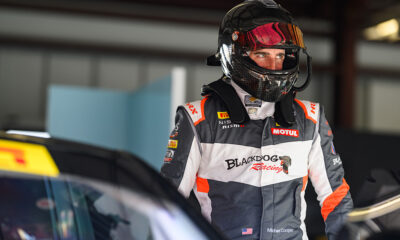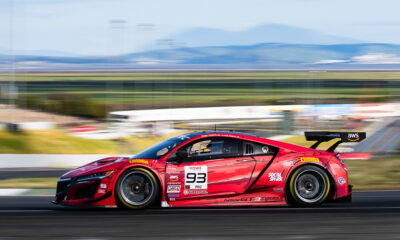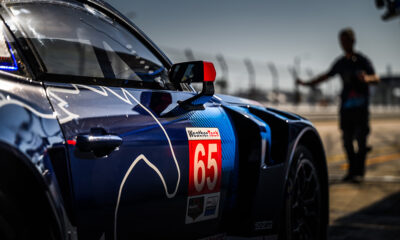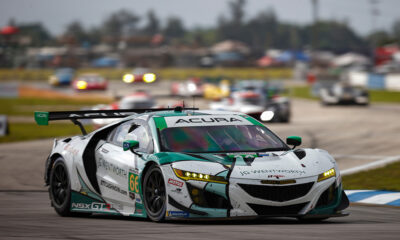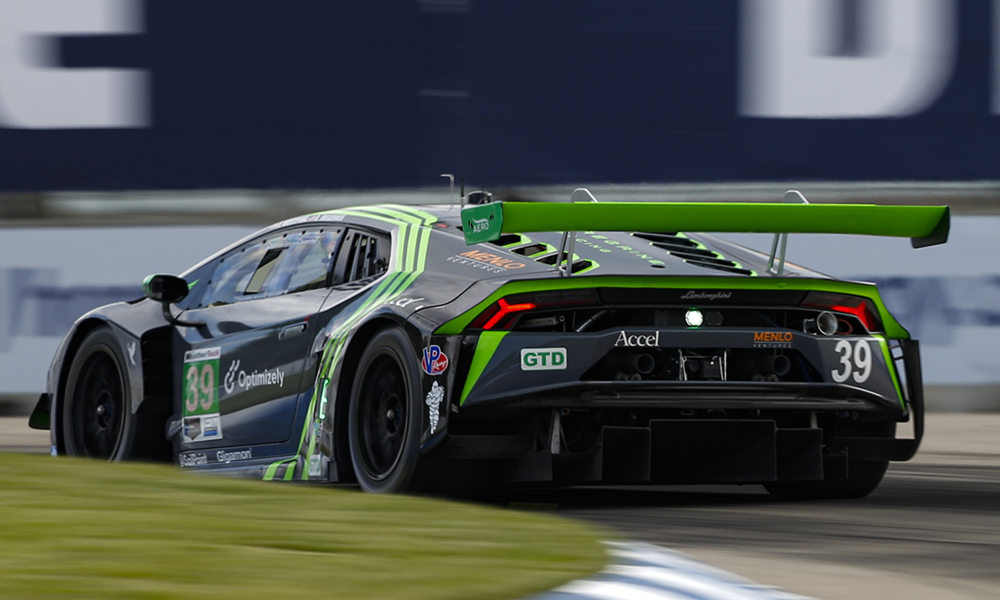
Photo: Jake Galstad/IMSA
The Belle Isle, Detroit Grand Prix brings back waves of memories for me. Memories of podiums, victories (nearly twice), and memories of a win that was stripped away due to fuel that poured into the car some 0.5 seconds too quickly during the race, which would not have changed any position or outcome on track, but rules are rules.
Belle Isle recalls memories of scuffs against the walls on the bumpy streets and near misses—moments that are an inevitable reality of racing at a street circuit because, let’s face it, we’re all human.
No matter who you are, NONE of us can do it exactly the same every single lap.
I haven’t been able to figure out how, and I haven’t seen any of my peers in either class achieve perfect consistency. The track itself is made up of park roads on an island between downtown Detroit and Windsor, Canada. With water on both sides, and a road that sees harsh winters every year, the surface is anything but pristine.
In fact, it’s quite the opposite, with cracks and seams that expand every year, new sealant patches to stop the degradation of the road and new concrete patches to fill holes in the asphalt.
With all those seams, pavement patches and sealant come the infamous bumps that make the Belle Isle circuit such a challenging place to race. One of the most infamous bumps is in Turn 2, over a bridge at 95-plus mph in our GT3 race cars, which recently restructured the body panels of a Corvette pace car leading the IndyCar field under caution.
I arrive to Detroit anticipating the need for quicker than quick reaction times, as my eyes will be scanning the road for debris, and I’ll rely on my peripherals to scan for the proximity to the walls.
Over the years, across many sports from childhood until now, I’ve learned that what you look at or focus on, you gravitate towards. Hence the peripherals for the walls, as staring at them does not promote speed.
The first session out, it always takes a few laps to get my bearings in terms of the width of the car, the bumps on the circuit that have changed, the flow of the line and where the rubber will eventually be built up in the coming sessions.
By lap five, I am able to start leaning on the car hard, meaning the sidewall “flex” in the tire becomes a target for me in all three phases of the corner: entry, middle and exit. This is when the rhythm starts building, speed gets faster, braking gets pushed later, the car starts sliding, and the risk begins.
I assess the handling of the car and report back to our engineer Steve Dinan, via radio, of a few needs I have in the car and the way it moves, slides, rolls and pitches around the 2.35-mile circuit.
I dive into the pits, the crew makes two changes to the chassis, and sends me back on my way. Leaving the pit lane, I turn off the pit limiter, the car squirms and slides, my shift lights illuminate in first gear, I grab second gear and launch over the bridge to get back up to speed and in the rhythm.
A few more out and ins, and I hand the car over to my teammate for him to get some familiarity with the street circuit.
Robert completes his practice and assessment of the track and car relationship and prepares himself for qualifying.
It’s a difficult thing, pushing and squeezing every inch of track for that one, near perfect lap. Nearest to the wall is where the dust and dirt collects, which reduces your grip and makes the slide/slip angle become faster in the final foot and a half until the concrete.
That’s what we mean when we say ‘threading the needle.’ Everything is more treacherous in the moments where the risk is the greatest.
Robert pushed hard and turned in his best lap of the weekend, a 1.29.7 which was 0.6 seconds off pole position this year and 0.8 seconds better than our own pole position last year in 2021 with the Audi R8.
This brings me to the race and the relative comparison of last year. Both Robert and I executed well, made no mistakes and maintained good averages relative to our best lap—meaning we were consistently running at the high end of the car’s ultimate potential.
I was 1 second a lap faster in the race this year compared to last year when we had the pace to win it. Yet, somehow, we were still missing a consistent 0.8 seconds to the front four cars.
All of those manufacturer’s cars have received a positive Balance of Performance from the series since Detroit 2021, and the Audi/Lambo pair have remained the same since then.
It’s the part of the sport I really don’t love commenting on publicly, however, when I was battling with the No. 51 Acura for sixth place, sliding the car into and out of the corner and scraping the vinyl off my mirror to make the lap time, at which point my pace is still not even close with that of the front runners, something isn’t right.
To look at another comparison, we typically loose 1-4 car lengths down the straight to all other makes while we are drafting them. On our own, the loss is greater.
The only hope is that there is some consolation for the performance gap between brands so we have a machine to fight with in the race.
We head to Watkins Glen next for the 6-hour, a track that usually favors cars with big torque and horsepower that can drag race from corner to corner, but we will push 100 percent regardless of the hand we are dealt and keep threading that needle!



















